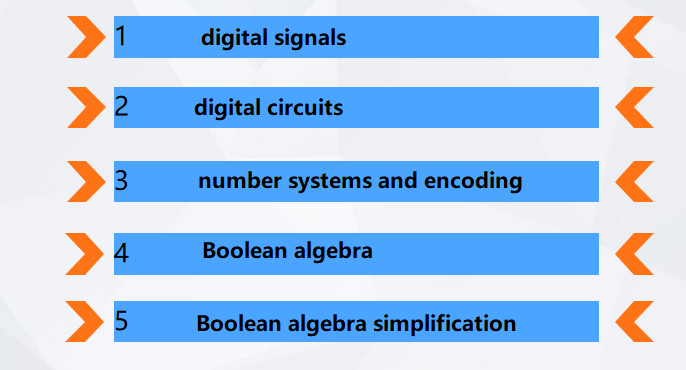Chapter 1 introduces the concepts and knowledge of digital circuit fundamentals, including digital signals, classification and basic principles of digital circuits, logic gate circuits, number systems and encoding, Boolean algebra and simplification.
Firstly, this chapter introduces the concepts, characteristics, and representation methods of digital signals, including basic concepts such as binary numbers, code elements, and sampling. Then, the classification and basic principles of digital circuits are explained, including combinational logic circuits and sequential logic circuits. Combinational logic circuits are circuits composed of logic gates, and their output only depends on the combination of input signals; sequential logic circuits not only have input signals but also have clock signals and state feedback. The output signal depends not only on the input signal but also on the circuit’s state.
Next, this chapter introduces the logic gate circuits of digital circuits, including basic logic gates such as AND gates, OR gates, NOT gates, XOR gates, their symbols, truth tables, and characteristics. Then, the number systems and encoding of digital circuits are introduced, including the representation methods and conversion of binary, octal, decimal, and hexadecimal, as well as the characteristics and applications of encoding methods such as BCD codes and Gray codes.
Finally, this chapter introduces Boolean algebra and simplification of digital circuits, including the basic definitions, operation rules, theorems, and equations of Boolean algebra, as well as the steps and techniques of logic function simplification using Karnaugh maps and Quine-McCluskey methods.
The contents of this chapter cover important concepts and knowledge points of digital circuit fundamentals, laying a solid foundation for subsequent learning and practice.
This chapter mainly introduces the following contents: digital signals, digital circuits, number systems and encoding, Boolean algebra and its simplification. In particular, number systems and encoding, and Boolean algebra simplification are not only the foundation of this course, but also the foundation of computer science and software/hardware design. The main contents of this chapter are shown in Figure 1.

When studying the content of this chapter, pay attention to the following points:
- What is a digital circuit?
- The relationship between digital signals and digital circuits.
-
- What is a digital signal, and why is it studied?
- What is an analog signal?
- What is the difference between digital signals and analog signals?
- What is the difference between digital signals and discrete signals?
- What is a digital circuit, and what is an analog circuit?
- What are the differences and connections between digital circuits and analog circuits?
- Number systems and counting methods.
- Why study Boolean algebra?
- What are the methods of logical simplification?